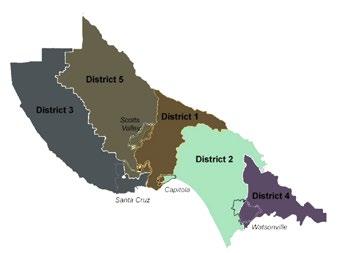
3 minute read
County Behavioral Health & Homeless Funding
By Zach Friend, Supervisor, Second District
Recently, Santa Cruz County was awarded a $10.1 million Behavioral Health Bridge Housing grant by California’s Department of Health Care Services to build a 35-unit development to serve homeless adults with behavioral health challenges. Once completed, it will provide housing for individuals enrolled in CARE Court and others with behavioral health challenges and part of an overall effort to reduce the impacts of homelessness, mental health and the housing crisis on our community.
Advertisement
In 2020, the Board of Supervisors created the Housing for Health Division to bring together a coalition of partners and resources focused on preventing and ending homelessness within the county. The division and its partners prioritize getting people off the streets and into permanent housing, particularly the most vulnerable. While homelessness continues to be one of our state’s most pressing challenges, locally some progress has been made -- as evidenced by the recent Pointin-Time Count showing a 21% decline in year-over-year homelessness in our county. Our COVID shelters represented the largest and longest sheltering operation in county history, and since then the county has moved more than 600 vulnerable individuals into permanent housing. Through two Encampment Resolution Grants, one underway and one recently awarded, more people are being moved out of encampments and into housing.
Permanent Supportive Housing
One of the largest housing challenges are for seniors, people with disabilities and those with behavioral health challenges. The county secured over $19 million in Project Homekey funding to build homes for formerly homeless veterans, families and others, and additional Homekey projects have been submitted for with an intent to build additional permeant supportive housing for vulnerable populations. The county should be hearing about the status of those applications in the coming months.
Additionally, Santa Cruz County Behavioral Health will soon have access to 100 new supportive housing units through projects currently under development throughout the community — Harvey West Studios and Jessie Street in Santa Cruz, Bienestar Plaza in Live Oak and Tabasa Gardens in Watsonville.
Additional Crisis Services
Inaddition to the permanent supportive housing projects listed above, the county is building a new Children’s Crisis Stabilization Center, providing 24 crisis stabilization and long-term care beds. This will provide a significant (and needed) infusion of crisis stabilization beds for youth in our community.
The county has also established mobile crisis intervention teams for adults and youth. These teams pair mental health liaisons with law enforcement agencies to de-escalate potentially violent situations.
Additionally, the county has behavioral health homeless outreach teams that connect people with necessary mental health, substance abuse treatment and other services and the county supports a 24-hour mental health help line and a local suicide prevention hotline.
The Board of Supervisors has increased funding for jail mental health services, and proposed changes in MediCal health insurance will make it easier to enroll justice-involved individuals in Medi-Cal so county staff can transition those exiting local jails without a gap in coverage.
But the headwinds facing our community are strong.
Santa Cruz County is now ranked as the least affordable rental market in the U.S., and our residents struggle with housing prices that place far too many at risk of homelessness. Studies show that homelessness spikes wherever the gap between incomes and the cost of living is high, and our own data show our homeless population are predominantly folks who lost housing because they could not find an affordable vacancy.
Too often, many families are competing for a single open unit causing significant housing insecurity and resulting in homelessness. While our region is building more new affordable and supportive housing than we have in a generation, the county, nonprofits and others are looking at other ways to partner to prevent people from losing their current housing.
For example, the county provided land and funding for Bienestar Plaza — 57 units of affordable housing and a low-cost health campus — and this is one way the county and other local jurisdictions can help provide additional housing to vulnerable populations. The county has pledged to make additional publicly owned parcels available for affordable and workforce housing.
As mentioned in previous articles, the county still faces a number of structural funding challenges. Due to state formulations, the county is systemically underfunded and have nowhere near the resources as other Bay Area and Central Coast communities — receiving just 13 cents out of every local property tax dollar compared to twice that amount in many comparable counties.


This means that much of your property tax dollar doesn’t come back to county government, requiring the county to meet these needs with less funding.
The federal funding we receive specifically for homelessness ($2,294 per individual) is low compared to other counties with high rates of homelessness, including San Mateo County ($9,294), San Francisco ($6,576), Marin County ($4,937), Sacramento ($4,867) and others. n
•••
As always, I appreciate any feedback you may have on this (or any other County issue). I’m maintaining regular updates on social media at www.facebook.com/supervisorfriend and you can always call me at 454-2200.









